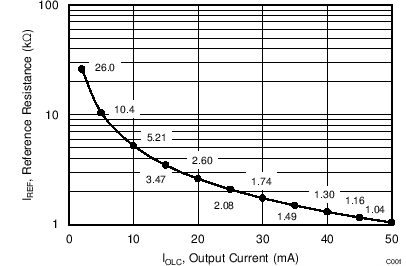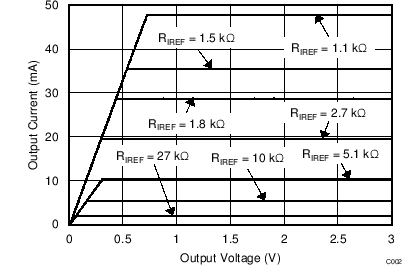SBVS225B March 2013 – May 2014 TLC5973
PRODUCTION DATA.
- 1 Features
- 2 Applications
- 3 Description
- 4 Revision History
- 5 Pin Configuration and Functions
- 6 Specifications
- 7 Parameter Measurement Information
- 8 Detailed Description
- 9 Applications and Implementation
- 10Power Supply Recommendations
- 11Layout
- 12Device and Documentation Support
- 13Mechanical, Packaging, and Orderable Information
6 Specifications
6.1 Absolute Maximum Ratings(1)
over operating free-air temperature range (unless otherwise noted)| MIN | MAX | UNIT | |||
|---|---|---|---|---|---|
| Voltage(2) | Supply, VCC | VCC | –0.3 | 7.0 | V |
| Input range, VIN | SDI | –0.3 | VCC + 1.2 | V | |
| Output range, VOUT | OUT0 to OUT2 | –0.3 | 21 | V | |
| SDO | –0.3 | 7.0 | V | ||
| Current | Output (dc), IOUT | OUT0 to OUT2 | 0 | 60 | mA |
| Operating junction temperature, TJ | –40 | 150 | °C | ||
(1) Stresses beyond those listed under Absolute Maximum Ratings may cause permanent damage to the device. These are stress ratings only, and functional operation of the device at these or any other conditions beyond those indicated under Recommended Operating Conditions is not implied. Exposure to absolute-maximum-rated conditions for extended periods my affect device reliability.
(2) All voltages are with respect to network ground pin.
6.2 Handling Ratings
| MIN | MAX | UNIT | |||
|---|---|---|---|---|---|
| Tstg | Storage temperature range | –55 | 150 | °C | |
| V(ESD) | Electrostatic discharge | Human body model (HBM), per ANSI/ESDA/JEDEC JS-001, all pins(1) | –8000 | 8000 | V |
| Charged device model (CDM), per JEDEC specification JESD22-C101, all pins(2) | –2000 | 2000 | |||
(1) JEDEC document JEP155 states that 500-V HBM allows safe manufacturing with a standard ESD control process.
(2) JEDEC document JEP157 states that 250-V CDM allows safe manufacturing with a standard ESD control process.
6.3 Recommended Operating Conditions
6.4 Thermal Information
| THERMAL METRIC(1) | TLC5973 | UNIT | |
|---|---|---|---|
| D (SO) | |||
| 8 PINS | |||
| RθJA | Junction-to-ambient thermal resistance | 134.6 | °C/W |
| RθJC(top) | Junction-to-case (top) thermal resistance | 88.6 | |
| RθJB | Junction-to-board thermal resistance | 75.3 | |
| ψJT | Junction-to-top characterization parameter | 37.7 | |
| ψJB | Junction-to-board characterization parameter | 74.8 | |
| RθJC(bot) | Junction-to-case (bottom) thermal resistance | N/A | |
(1) For more information about traditional and new thermal metrics, see the IC Package Thermal Metrics application report, SPRA953.
6.5 Electrical Characteristics
At TA = –40°C to 85°C, VCC = 3 V to 6.0 V, and CVCC = 0.1 µF. Typical values at TA = 25°C and VCC = 5.0 V, unless otherwise noted.| PARAMETER | TEST CONDITIONS | MIN | TYP | MAX | UNIT | ||
|---|---|---|---|---|---|---|---|
| VOH | High-level output voltage (SDO) | IOH = –2 mA | VCC – 0.4 | VCC | V | ||
| VOL | Low-level output voltage (SDO) | IOL = 2 mA | 0 | 0.4 | V | ||
| VIREF | Reference voltage output | RIREF = 1.5 kΩ | 1.18 | 1.20 | 1.23 | V | |
| VR | Shunt regulator output voltage (VCC) | ICC = 1 mA, SDI = low | 5.9 | V | |||
| ICC0 | Supply current (VCC) | VCC = 3.0 V to 5.5 V , SDI = low, all grayscale (GSn) = FFFh, VOUTn = 1 V, SDO = 15 pF, RIREF = 27 kΩ (IOUTn = 2-mA target) |
3 | 6 | mA | ||
| ICC1 | VCC = 3.0 V to 5.5 V, SDI = low, all grayscale (GSn) = FFFh, VOUTn = 1 V, SDO = 15 pF, RIREF = 3 kΩ (IOUTn = 17-mA target) |
4 | 7 | mA | |||
| ICC2 | VCC = 3.0 V to 5.5 V, SDI = 5 MHz, all grayscale (GSn) = FFFh, VOUTn = 1 V, SDO = 15 pF, RIREF = 3 kΩ (IOUTn = 17-mA target) |
5 | 8 | mA | |||
| ICC3 | VCC = 3.0 V to 5.5 V, SDI = 5 MHz, all grayscale (GSn) = FFFh, VOUTn = 1 V, SDO = 15 pF, RIREF = 1.5 kΩ (IOUTn = 34-mA target) |
5.5 | 10 | mA | |||
| IOLC | Constant output current (OUT0 to OUT2) |
All OUTn = on, VOUTn = 1 V, VOUTfix = 1 V, RIREF = 1.5 kΩ |
31 | 34 | 37 | mA | |
| IOLKG | Output leakage current (OUT0 to OUT2) |
GSn = 000h, VOUTn = 21 V | TJ = –40°C to 85°C | 0.1 | μA | ||
| TJ = 85°C to 125°C | 0.2 | μA | |||||
| ΔIOLC0 | Constant-current error (channel-to-channel)(1) |
All OUTn = on, VOUTn = VOUTfix = 1 V, RIREF = 1.5 kΩ | ±0.5% | ±3% | |||
| ΔIOLC1 | Constant-current error (device-to-device)(2) |
All OUTn = on, VOUTn = VOUTfix = 1 V, RIREF = 1.5 kΩ | ±0.5% | ±6% | |||
| ΔIOLC2 | Line regulation of constant-current output(3) | All OUTn = on, VOUTn = VOUTfix = 1 V, RIREF = 1.5 kΩ | ±0.5 | ±1 | %/V | ||
| ΔIOLC3 | Load regulation of constant-current output(4) | All OUTn = on, VOUTn = VOUTfix = 1 V, RIREF = 1.5 kΩ | ±0.5 | ±1 | %/V | ||
| RPD | Internal pull-down resistance (SDI) | At SDI | 1 | MΩ | |||
(1) The deviation of each output (OUT0 to OUT2) from the constant-current average. Deviation is calculated by the formula: 
, where n = 0 to 2.

, where n = 0 to 2.
(2) Deviation of the constant-current average in each color group from the ideal constant-current value. Deviation is calculated by the formula:

Ideal current is calculated by the formula:

, where n = 0 to 2.

Ideal current is calculated by the formula:

, where n = 0 to 2.
(3) Line regulation is calculated by the formula:

, where n = 0 to 2.

, where n = 0 to 2.
(4) Load regulation is calculated by the equation:

, where n = 0 to 2.

, where n = 0 to 2.
6.6 Switching Characteristics
At TA = –40°C to 85°C, VCC = 3.0 V to 5.5 V, CL = 15 pF, RL = 110 Ω, and VLED = 5.0 V, unless otherwise noted.Typical values are at TA = 25°C and VCC = 5.0 V.
| PARAMETER | TEST CONDITIONS | MIN | TYP | MAX | UNIT | |
|---|---|---|---|---|---|---|
| tR0 | Rise time | SDO | 2 | 6 | 12 | ns |
| tR1 | OUTn (on → off) | 200 | 400 | ns | ||
| tF0 | Fall time | SDO | 2 | 6 | 12 | ns |
| tF1 | OUTn (off → on) | 200 | 400 | ns | ||
| tD0 | Propagation delay | SDI↑ to SDO↑ | 30 | 50 | ns | |
| tD1 | OUT0↓ to OUT1↓, OUT1↓to OUT2↓, OUT0↑ to OUT1↑, OUT1↑to OUT2↑ |
25 | ns | |||
| tWO | Shift data output one pulse duration | SDO↑ to SDO↓ | 15 | 25 | 45 | ns |
| fOSC | Internal GS oscillator frequency | 8 | 12 | 16 | MHz | |
6.7 Typical Characteristics
At TA = 25°C and VCC = 12 V, unless otherwise noted.

| VCC = 5 V | ||